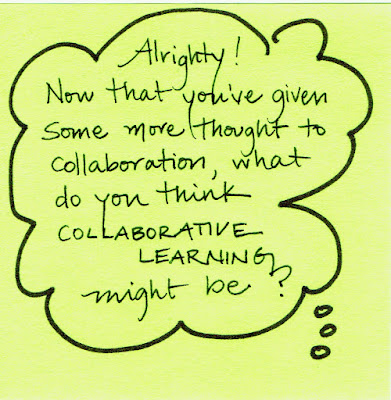I think about collaboration all the time. In my career I've had some amazing collaborative successes and some pretty tough failures, so I'm always looking to learn more. I met Ivy Young several years ago and we've continued to have great conversations around all sorts of things--but our talk turned to collaborations recently, so I've asked her to share some thoughts from her time as director of the California Networks for Collaboration, a project of the California Association of Museums. Ivy is currently working as a consultant for learning design and the facilitation of collaborative processes. She starts us off by reflecting on the question she posts above.
Some of my immediate thoughts include:
- Collaboration cannot be done alone – it involves a group of people.
- Collaboration requires trust and mutual respect. Without establishing core, shared values at the outset, collaboration risks failing.
- The collaborative process is organic and can be difficult! It requires commitment.
- Communication pathways need to be clear and remain open.
- It’s most meaningful, insightful, and produces the best outcomes when the collaborative group is diverse. (Diverse across multiple dimensions: age, gender, culture, race, ethnicity, religion, socioeconomics, education, abilities, etc.)
- Collaboration takes a lot time. And sometimes it may just feel that it’s easier to go at the work alone.
- Often, collaboration yields new ideas or new innovations.
- Strong collaboration has deeper impacts and broader reaches. It has the potential to strengthen organizations, communities, and networks.
What would you like to add to this list? Please share in the comments below. Let’s keep it going!
Truth be told, I’ve spent a considerable amount of time thinking about collaboration. The above reflections have largely been shaped by my experiences in helping to steer the California Networks for Collaboration (CNfC)– an aptly titled project at that! Collaboration was at the very heart of the project and all CNfC stakeholders were engaged in collaborative processes throughout, from esteemed advisors to voluntary participants.
In the briefest of nutshells, the CNfC is a four-phase, multi-year project that is directed by the California Association of Museums (CAM) in collaboration with 13 other partner organizations statewide. In the CNfC phase that I helped to oversee, we brought museum thought leaders together to create three different curricula for studies focusing on engagement strategies, audience research, and accessibility. CAM and CNfC project partners then activated their professional networks across the state to bring together multiple study groups, or what we called “Learning Collaboratives”, around these three topics. In this, we were piloting how to leverage multiple, informal networks around a focused endeavor as well as we were testing a model for professional development based on the concept of collaborative learning.
With CNfC Learning Collaboratives we sought to provide more collaborative experiences for participants than what might be expected of the traditional study group or professional development experience. This chart, originally created by consultant Marsha Rhea, compares the two learning environments:
Learning Collaboratives
|
Study Groups
|
Knowledge co-creation focuses on participant meaning making
|
Knowledge transfer focuses on participant comprehension
|
Participant-centered
|
Facilitator-centered
|
The atmosphere is social and organic
|
The atmosphere is more structured and predefined
|
Participant experience is interactive –
“Ask me!”
|
Participant experience is more passive –
“Feed me.”
|
Context rich
|
Content rich
|
Driven by participant interests
|
Driven by facilitator’s (or expert’s) interests
|
With this, imagine groups of museum and arts & culture professionals (anywhere from 5 to 16 people, including the regional facilitator) coming together in different regions throughout California for a six-month period...Each group met together in real life once a month and also had the opportunity to connect in a social networking forum between meetings, had access to live, monthly webinars with museum thought leaders, and were provided with a curated list of recommended readings and optional activities to also peruse outside of meeting.
The in-person meetings tended to be the most important anchor for the Learning Collaborative experience. These often included a number of different interactive protocols for a diversity of spoken and written interactions to help construct shared learning.
In fact, some of the protocols used in the Learning Collaborative meetings were sourced from Linda’s (and Rainey Tisdale’s) book, Creativity in Museum Practice, such as mind mapping (p.38), brainwriting (p. 136), and the butterfly test (p. 137). (And, what’s more, the CNfC project is mentioned in the publication! See page 159.) With all of these different activities for exchanging and cultivating ideas, you better believe the Learning Collaborative groups came up with some great insights to apply to museum practice!
Each group worked together collaboratively to document their most salient takeaways at the conclusion of their studies. These takeaways – what we called “knowledge products”– took on many different forms from pocket checklists to interactive Prezi presentations, to games and annotated bibliographies. Any form, really, that the Learning Collaborative thought would be best to convey their findings. You can access all 37 of the CNfC Learning Collaborative knowledge products here.
Stay tuned for Part 2, featuring some of Ivy's favorite Knowledge Products and be sure to share your thoughts on collaboration in the comments.




















